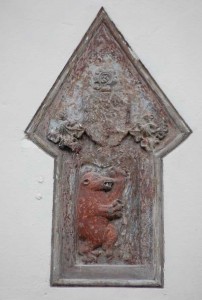The Bear Tavern in Newburgh dates back to the late eighteenth century and has a close historic association with nearby Lindores Abbey.
The pub takes its name from the bear stone above the door to the pub, which was originally set into the abbot’s residence at Lindores Abbey. The ‘Bear with the Ragged Staff’ was the heraldic device of the de Beaumont family from Normandy.  The de Beaumonts came to these shores with William the Conqueror and, for services rendered Henry de Beaumont was made Earl of Warwick in 1088. Henry de Beaumont’s father had granted him the Lordship of Le Neuborg in central Normandy and he adopted for himself and his descendants the Anglicised version of Neuborg as the surname of de Newburgh.
The de Beaumonts came to these shores with William the Conqueror and, for services rendered Henry de Beaumont was made Earl of Warwick in 1088. Henry de Beaumont’s father had granted him the Lordship of Le Neuborg in central Normandy and he adopted for himself and his descendants the Anglicised version of Neuborg as the surname of de Newburgh.
‘The ‘Bear with the Ragged Staff’ was the heraldic device of the de Beaumont family from Normandy’
Lindores Abbey was founded in1191 by David, Earl of Huntingdon and brother of William I of Scotland (William The Lion). It is believed that the first Abbot, Guido, was a younger son of the de Beaumont family and had the de Beaumont family device carved in stone and placed above the door to his residence at the Abbey. The Abbey was left in ruins following its destruction during the Reformation in the sixteenth century but the stone carving of the family crest was rescued and was incorporated into the building of the Bear Tavern where it can be seen to this day. Lindores Abbey’s principal claim to fame is that it features in the first written record of Scotch whisky. A commission from King James IV gave Friar John Cor of Lindores the rights to be granted eight bolls of malt with which to make aqua vitae and therefore the Abbey was probably the first organised distillery and certainly the first officially recognised one. Whisky academics consequently consider Lindores Abbey to be the birthplace of whisky and accordingly worthy of pilgrimage. In view of this, plans are in place for a new distillery and visitor centre to be built close to the site of the original Abbey.






